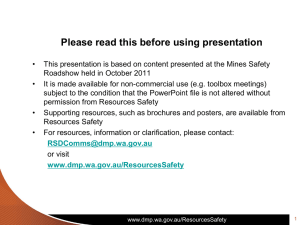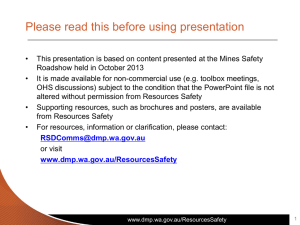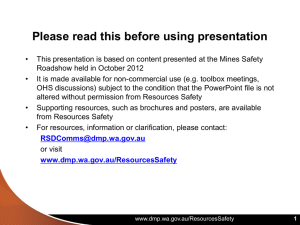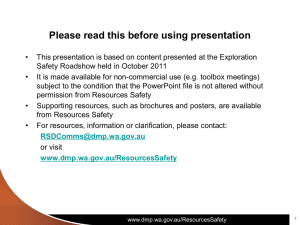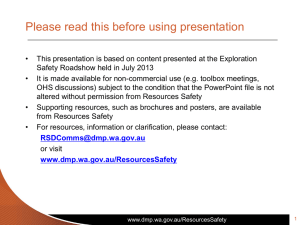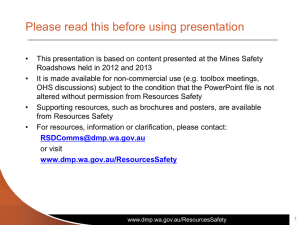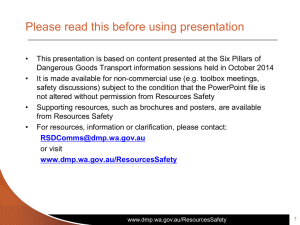MS - Toolbox Presentation - 2015 Structural integrity forum
advertisement
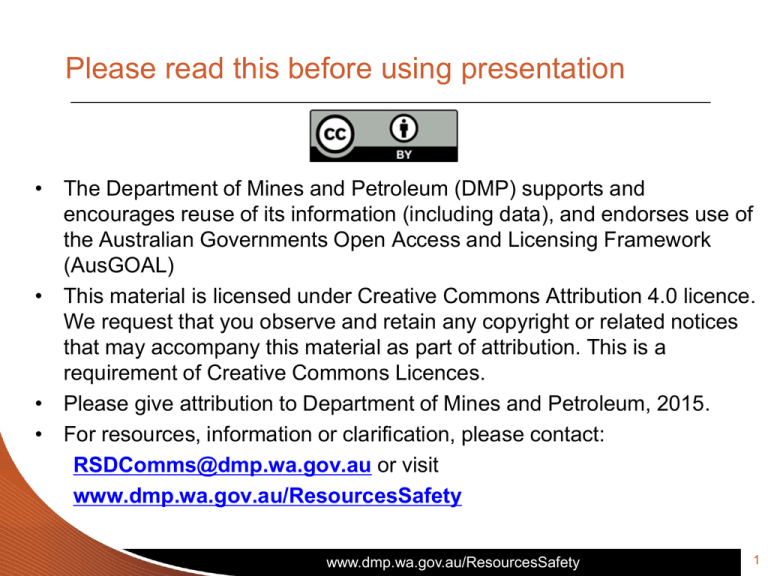
Please read this before using presentation • The Department of Mines and Petroleum (DMP) supports and encourages reuse of its information (including data), and endorses use of the Australian Governments Open Access and Licensing Framework (AusGOAL) • This material is licensed under Creative Commons Attribution 4.0 licence. We request that you observe and retain any copyright or related notices that may accompany this material as part of attribution. This is a requirement of Creative Commons Licences. • Please give attribution to Department of Mines and Petroleum, 2015. • For resources, information or clarification, please contact: RSDComms@dmp.wa.gov.au or visit www.dmp.wa.gov.au/ResourcesSafety www.dmp.wa.gov.au/ResourcesSafety 1 Structural integrity: What is your responsibility? www.dmp.wa.gov.au/ResourcesSafety 2 What are we going to cover? • Duties of: – Designers – Manufacturers – Importers – Suppliers – Installers and erectors – Principal employers – Employees – Other employers and self-employed persons • Risk-based and precautionary approaches to meeting duty of care obligations www.dmp.wa.gov.au/ResourcesSafety 3 Words of wisdom Words of wisdom from a management guru: William Edwards Deming. 1. “Learning is not compulsory….But neither is survival.” 2. “The worker is not the problem. The problem is at the top! Management!” 3. “A system must be managed. It will not manage itself.” www.dmp.wa.gov.au/ResourcesSafety 4 Setting the scene • Mines Safety Bulletin no. 43 issued in August 1998 is still highly relevant today. • Inspectors are continuing to observe the same type of issues raised in MSB 43 with disturbing frequency: – – – – – – Excessive corrosion damage Dangerous modifications Inadequate design Drawings missing important design information As-built plant not checked or verified against design Structural integrity not proactively managed over life cycle www.dmp.wa.gov.au/ResourcesSafety 5 Is it safe? Managing plant structures Does full compliance with legislation = Safe? Does full compliance with Australian Standards = Safe? Does controlling risks to pre-defined residual risk levels = Safe? Does controlling risks to ALARP levels (As Low As Reasonably Practicable) = Safe? Does controlling risks to SFAIRP levels (So Far As is Reasonably Practicable) = Safe? Does controlling risks using a ‘safety case’ = Safe? What criteria do the courts apply when deciding negligence or breach of duty of care? When is it safe enough? www.dmp.wa.gov.au/ResourcesSafety 6 Consider these duties and obligations • • • • • • • • Designers Manufacturers Importers Suppliers Installers and erectors Principal employers Employees Other employers and self-employed persons www.dmp.wa.gov.au/ResourcesSafety 7 Designers • Specific duties of designers of plant given in section 14 (MSIA) and regulations 6.3, 6.4, 6.5 and 6.33 (MSIR) ― these parts of legislation are specifically directed at the designer and may potentially be used in a prosecution of a designer • Many other parts of MSIA and MSIR also affect how plant is designed but are not specifically directed at designer ― they are directed at manager of the mine or responsible person at the mine • Also a general duty of care under common law www.dmp.wa.gov.au/ResourcesSafety 8 Manufacturers • Specific duties for manufacturers of plant are in section 14 (MSIA) and regulations 6.6, 6.7 and 6.8 (MSIR) ― these relate to hazard identification, risk assessment and risk reduction • If the designer is outside of the jurisdiction of the State, the manufacturer is responsible for the duties of designer (MSIR reg. 6.6) • Also a general duty of care under common law www.dmp.wa.gov.au/ResourcesSafety 9 Importers • Specific duties for importers of plant are in section 14 (MSIA) and regulations 6.9, 6.10 and 6.11 (MSIR) ― these relate to hazard identification, risk assessment, risk reduction and provision of adequate information • If designer and manufacturer are outside of the jurisdiction of the State, importer is responsible for duties of designer and manufacturer (MSIR regulation 6.9) • Also a general duty of care under common law www.dmp.wa.gov.au/ResourcesSafety 10 Suppliers • Specific duties for suppliers of plant are in section 14 (MSIA) and regulations 6.12 and 6.13 (MSIR) ― these relate to risk assessment and providing adequate information • Persons can become a supplier through hiring or leasing of plant ― duties of such persons are covered by regulation 6.14 (MSIR) • Also a general duty of care under common law www.dmp.wa.gov.au/ResourcesSafety 11 Installers and erectors • Specific duties of installers and erectors are in section 14 (MSIA) and regulations 6.15 and 6.16 (MSIR) ― these relate to hazard identification, risk assessment and risk reduction • Also a general duty of care under common law www.dmp.wa.gov.au/ResourcesSafety 12 Principal employers In relation to plant safety, the main obligations placed on principal employer include: • Section 9 (MSIA) (Employer’s duty of care) • Reg. 6.2 (MSIR) (Plant to be operated and maintained in a safe manner) • Regs 6.17, 6.18 (Risk identification and hazard reduction) • Reg. 6.20 (Installation and maintenance) • Reg. 6.21 (Prevention of unsafe use) • Reg. 6.22 (Duties when plant is damaged or repaired) • Reg. 6.24 (Dismantling and Storage) www.dmp.wa.gov.au/ResourcesSafety 13 Principal employers continued • • • • • • • Reg. 6.25 (Keeping of records) Reg. 6.26 (Plant under pressure) Reg. 6.27 (Plant with moving parts) Reg. 6.28 (Plant with hot or cold parts) Reg. 6.29 (Electrical hazards) Regs 6.30, 6.31 (Industrial robots and lasers) Part 6, Division 3 (MSIR) – Suite of regulations relating to classified plant and registered classified plant • Reg. 4.4 (Guards and handrails) www.dmp.wa.gov.au/ResourcesSafety 14 Principal employers (continued) • Reg. 4.10 (Safety signs) • Numerous regulations in Parts 11 and 12 (MSIR) that relate to winding engines, hoists and shaft sinking equipment • Numerous regulations in Part 14 (MSIR) that relate to dredges www.dmp.wa.gov.au/ResourcesSafety 15 Employees Main duties of employees are in section 10 (Employee’s duty of care) and section 11 (Reporting of occurrences) of the MSIA www.dmp.wa.gov.au/ResourcesSafety 16 Other employers and self-employed persons • Duties are in section 12 (MSIA) • Essentially a duty of care requirements www.dmp.wa.gov.au/ResourcesSafety 17 Complying with duty of care responsibilities – risk-based approach Risk management methodology of AS/NZS ISO 31000 includes following steps: 1. Establish the context – decide risk assessment criteria 2. Risk identification – Hazard ID 3. Risk analysis – Determine existing controls, likelihood and severity 4. Risk evaluation – Compare calculated risk level against acceptable risk criteria 5. Risk treatment – Develop and implement actions to reduce risk to acceptable levels www.dmp.wa.gov.au/ResourcesSafety 18 Risk management process www.dmp.wa.gov.au/ResourcesSafety 19 AS 5104:2005 General principles on reliability of structures Introduces concept of a target ‘Reliability Index’ (β) or failure probability for structures. These apply to the ultimate and serviceability limit states of structure for a defined period of time (design life). β = 4.7 corresponds to probability of a person present in building at time of collapse getting killed, P = 10-6 per year. AS 1170 codes are based on this criteria. However, despite β value used by designers, most failures are actually result of ‘gross errors’ www.dmp.wa.gov.au/ResourcesSafety 20 What does the legislation say? • Current mines safety legislation does not require risk of structural failure to be controlled to a predetermined risk or reliability level • Expectation of employer’s duty of care obligations (section 9 MSIA) is that all risks of employees exposure to hazards are controlled to SFAIRP levels (So Far As Is Reasonably Practicable) • Reasonably practicable is defined in section 4(1) (MSIA) www.dmp.wa.gov.au/ResourcesSafety 21 Complying with duty of care responsibilities – precautionary approach • Focused on controls rather than evaluating risk or residual risk • Ensuring all reasonably practicable precautions are in place ― achieving the highest level of protection (SFAIRP) requires you to demonstrate ‘due diligence’ • Risk management approach is about adding enough controls or precautions until an acceptable or tolerable level of residual risk is achieved ― requires you to demonstrate appropriate risk assessment. www.dmp.wa.gov.au/ResourcesSafety 22 Complying with duty of care responsibilities – precautionary approach A ‘safety case’ is a documented due diligence argument as to why an operation is considered to be safe. “ …the safety case is a document – meant to be kept up to date – in which the operator sets out its approach to safety and the safety management system which it undertakes to apply….” Lord Cullen, 2001 Major Hazard Facilities (MHF) operate under a safety case environment – a contract between the organisation and the regulator that permits the organisation to operate within defined limits and in accordance with documented procedures www.dmp.wa.gov.au/ResourcesSafety 23 Discussion • • • • Has this column already failed? What is correct response? Who is responsible and accountable for managing such an issue on your site? What management systems do you have to control such hazards? www.dmp.wa.gov.au/ResourcesSafety 24 Discussion • • • • Has this pedestal already failed? What is the correct response? Who is responsible and accountable for managing such an issue on your site? What management systems do you have to control such hazards? www.dmp.wa.gov.au/ResourcesSafety 25 Some key messages to take away 1. The minimum safety factors required by the codes (AS 1170) that are built into properly designed and built structures must not be allowed to degrade over time for any reason. Otherwise this may expose personnel to hazards (i.e. breach of duty of care & Reg. 6.22). Therefore, additional robustness may be required in the initial design of mining structures and adequate controls put into effect to manage the inevitable misuse and damage. 2. Minimise gross errors by ensuring persons involved in designing, verifying, fabricating, installing, inspecting, repairing and maintaining plant structures are suitably competent. www.dmp.wa.gov.au/ResourcesSafety 26 More key messages 3. Establish reliable systems of work, procedures and sufficient resources to manage plant structures at all stages of the plant design life such that their reliability is not compromised. Plant structures will not manage themselves. 4. Don’t use risk assessments as an tool to justify doing nothing or deferring action. You cannot “kick the can down the road” forever. Adopt a precautionary approach ― be diligent and focus on having adequate risk controls ― use risk assessments to prioritise repair actions rather than defer them. www.dmp.wa.gov.au/ResourcesSafety 27
